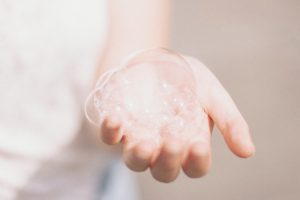Are shampoos really that toxic? How do I know if my shampoo is toxic? Should we be reading shampoo labels?
If you are what you eat, surely you are also what you put on your hair and body. But in the increasingly health-conscious, plant-based world of ours, everyone seems to be forgetting that whatever ingredient you put in your hair, scalp, or skin is absorbed into your bloodstream too. That’s right, your hair too!
Label reading is in, and for very good reasons too, given the endless list of undesirable, filler ingredients in a lot of food products. But it seems the vast majority of people are ignoring the big elephant in the room: what about beauty care labels?? When was the last time you read and understood your shampoo label? If you have in the past 3 months, pat yourself in the back for being one of a very wise, ever-increasing, but still, minority of us that are growing more and more concerned with vague, undeclared ingredients we have simply ignored for far too long.
In a Stanford University study mice were vaccinated through shampoo thanks to hair follicles, and that has serious implications for all of us, but especially for anyone who regularly lathers his/her hair with hair products full of toxic ingredients. Formaldehyde, anyone?
Let us examine the poo in Shampoo, shall we?

– Ammonium Lauryl Sulfate, Sodium Laureth Sulfate (SLES), & Sodium Lauryl Sulfate (SLS)
Surfactants that bind oil and water together to help remove oil, whether from your skin, hair, or even dishes. It increases the spreading and wetting properties of a product, and acts as a foaming agent. But they also weaken your skin’s natural defences causing irritation, stripping natural oils from your scalp and hair, making it dry, brittle, slowing down hair growth, and causing thinning. SLS is so known to cause skin irritation that, in dermatological testing, new products are compared to SLS to check how irritating they might be to human skin.
– Diethanolamine (DEA), Triethanolamine (TEA) & Monoethanolamine (MEA)
DEA, TEA & MEA are clear, colourless organic chemical substances that act as emulsifiers and foaming agents to produce bubbles and foam, as well as to control pH levels in shampoos, hair conditioners, soaps, shaving creams, eye shadows, etc. NDEA is a known carcinogen, and both TEA & DEA have been found to produce liver cancer. DEA also affects the male reproductive system altering the sperm structure.
– Dimethicone
A type of silicone or plastic that coats your hair, supposedly to give it shine, but since it is not water-soluble no matter how many times you rinse it your hair will feel greasier, and more lifeless over time due to the coat that blocks hydration and nutrients out, causing hair loss, skin irritation, and allergic contact dermatitis. 
– Formaldehyde
A chemical that prevents microbes from growing in water-based products. So much so that traditionally Formaldehyde has been used in embalming, where the body would be drained of blood, and filled with formaldehyde to keep tissues from deteriorating. It is a known carcinogenic that is easily absorbed through our skin. It appears under many names such as:
quaternium-15, DMDM hydantoin, imidazolidinyl urea, diazolidinyl urea, polyoxymethylene urea, sodium hydroxymethylglycinate, 2-bromo-2-nitropropane-1,3-diol (bronopol), and glyoxal (amongst others).
– Parabens
A preservative that prevents bacteria from growing, acts like the hormone estrogen, disrupts the normal functioning of the reproductive system (reproductive development, fertility, and birth), and increases the growth of breast cancer cells.
We believe we have the right to make educated choices rather than guesses. Time for change!
Fancy reading some more?
– Agents Classified by the IARC Monographs, Volumes 1–109 Available
http://monographs.iarc.fr/ENG/Classification/ClassificationsAlphaOrder.pdf
– American Cancer Society:
https://www.cancer.org/cancer/cancer-causes/formaldehyde.html#:~:text=The%20EPA%20has%20classified%20formaldehyde,particularly%20myeloid%20leukemia%2C%20in%20humans.
– Campaign for Safe Cosmetics
https://www.safecosmetics.org/get-the-facts/chem-of-concern
– European Chemical Agency (ECHA)
https://echa.europa.eu/substance-information/-/substanceinfo/100.000.131
– Journal of Investigative Dermatology
https://www.sciencedirect.com/science/article/pii/S0022202X9091287L
– National Toxic Encephalopathy Foundation
https://www.national-toxic-encephalopathy-foundation.org/

